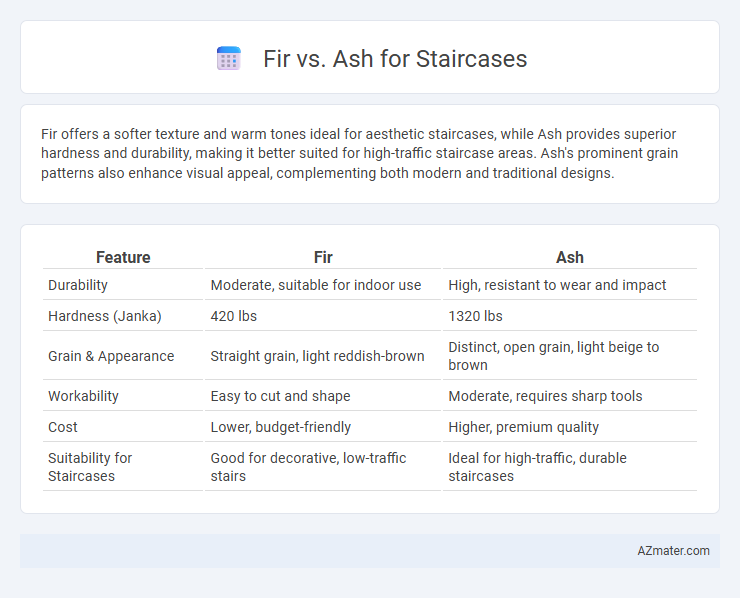Fir offers a softer texture and warm tones ideal for aesthetic staircases, while Ash provides superior hardness and durability, making it better suited for high-traffic staircase areas. Ash's prominent grain patterns also enhance visual appeal, complementing both modern and traditional designs.
Table of Comparison
| Feature | Fir | Ash |
|---|---|---|
| Durability | Moderate, suitable for indoor use | High, resistant to wear and impact |
| Hardness (Janka) | 420 lbs | 1320 lbs |
| Grain & Appearance | Straight grain, light reddish-brown | Distinct, open grain, light beige to brown |
| Workability | Easy to cut and shape | Moderate, requires sharp tools |
| Cost | Lower, budget-friendly | Higher, premium quality |
| Suitability for Staircases | Good for decorative, low-traffic stairs | Ideal for high-traffic, durable staircases |
Introduction: Fir vs Ash for Staircase
Fir and ash are popular wood choices for staircases due to their durability and aesthetic appeal. Fir offers a straight grain and lighter color, making it ideal for contemporary designs, while ash provides a stronger, more resilient structure with a distinctive grain pattern suitable for traditional or rustic styles. Selecting between fir and ash depends on desired strength, appearance, and budget considerations in staircase construction.
Wood Characteristics: Fir and Ash
Fir wood offers a straight grain and soft texture, making it easy to work with and suitable for smooth finishes in staircase construction. Ash is known for its hardness and durability, displaying a prominent grain pattern that adds natural aesthetic appeal and increased resistance to wear. Both woods provide strong structural integrity, but ash provides superior impact resistance, ideal for high-traffic staircases.
Durability and Strength Comparison
Fir wood offers moderate durability and strength, making it suitable for staircases in residential settings with light to moderate foot traffic. Ash wood, renowned for its high density and excellent shock resistance, provides superior strength and durability, ideal for staircases subject to heavy use and impact. Choosing ash ensures a longer-lasting staircase with enhanced load-bearing capacity and resistance to wear compared to fir.
Visual Appearance and Grain Patterns
Fir wood offers a warm, reddish tone with a straight, uniform grain that creates a smooth and consistent visual appeal for staircases. Ash, on the other hand, displays a lighter color palette, often creamy to pale yellow, with prominent, bold grain patterns that add dynamic texture and character. Choosing between Fir and Ash depends on whether you prefer a subtle, even finish or a more striking, natural grain contrast in your staircase design.
Cost and Availability
Fir wood is generally more affordable than ash, making it a cost-effective option for staircases without compromising structural integrity. Fir is widely available, especially in North America, ensuring consistent supply for construction projects. Ash, while slightly more expensive, offers superior hardness and durability, but its availability can be limited depending on the region, potentially increasing lead times and overall costs.
Maintenance Requirements
Fir wood requires regular sealing and varnishing to protect against moisture and wear, as it is more susceptible to scratches and dents compared to ash. Ash offers greater natural durability and resistance to damage, reducing the frequency of refinishing and repairs needed for staircase maintenance. Choosing ash can lead to lower upkeep costs and longer-lasting aesthetic appeal in high-traffic areas.
Suitability for High-Traffic Areas
Fir wood offers moderate durability with a Janka hardness rating around 660, making it suitable for staircases in low to moderate traffic areas but less ideal for heavy use. Ash wood, with a higher Janka hardness of approximately 1320, provides superior resistance to wear and impact, making it a preferred choice for high-traffic staircases demanding long-lasting performance. The dense and tough grain structure of Ash ensures greater stability and reduces surface damage over time compared to the softer and more prone-to-dent Fir.
Ease of Installation and Workability
Fir wood offers superior ease of installation for staircases due to its lightweight nature and straight grain, allowing for smoother cutting and nailing. Ash is known for excellent workability, providing durability and resistance to wear while being slightly harder to manipulate compared to fir. Both woods accommodate fine finishes well, but fir typically reduces labor time in the installation process because of its softer texture.
Best Applications for Fir and Ash
Fir wood, valued for its straight grain and moderate strength, excels in staircases requiring stability with a lighter aesthetic, ideal for contemporary or rustic interiors. Ash, recognized for its superior hardness and shock resistance, is preferred for high-traffic staircases demanding durability and wear resistance, making it suitable for both traditional and modern designs. Both woods perform well in indoor settings, with fir enhancing design flexibility and ash offering robust longevity.
Conclusion: Choosing the Right Wood for Your Staircase
Fir offers excellent strength and a lighter color that brightens staircase spaces, while ash provides superior hardness and distinctive grain patterns ideal for rustic or contemporary designs. Selecting between fir and ash depends on desired durability, aesthetic appeal, and budget considerations, with ash generally commanding a higher price due to its density and wear resistance. Prioritize ash for high-traffic areas requiring long-lasting performance, whereas fir suits projects seeking cost-effective, visually warm timber.

Infographic: Fir vs Ash for Staircase
 azmater.com
azmater.com